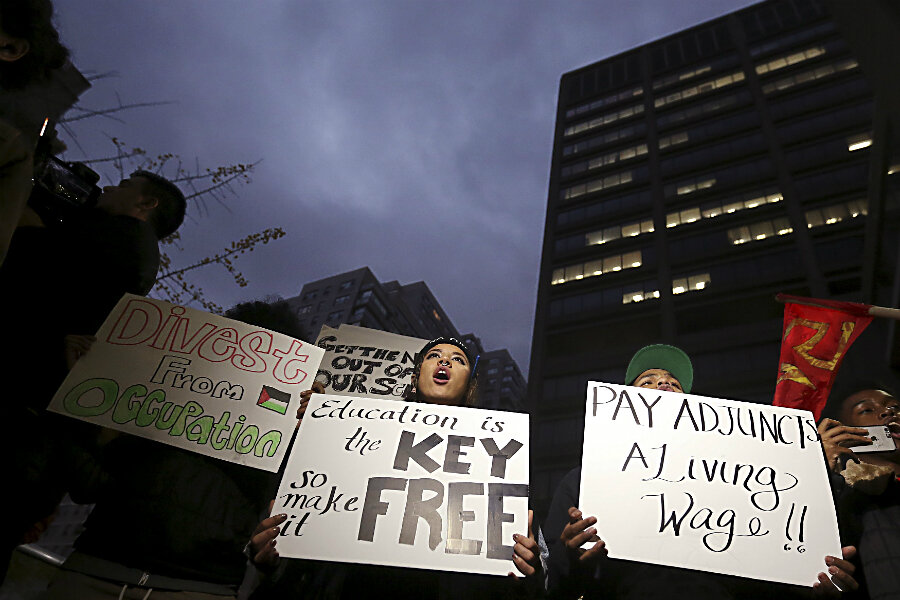Student loan delinquencies reveal racial disparities
Loading...
Student debt tops $1.2 trillion, a figure that’s led to hearty debate in the United States about whether the high price of college is worth it.
But it’s not just the amount of debt that someone takes on that matters. It also comes down to how well positioned one is to pay it back. And that’s an area where racial disparities show up glaringly – in a new set of student-debt delinquency heat maps released Wednesday by two groups pushing for solutions to income inequality.
The maps are a visual reminder of the racial and economic inequality issues that have been playing out in campus protests and along the presidential campaign trail.
ZIP Code by ZIP Code, they show that the highest levels of delinquency on student loans are in neighborhoods with higher concentrations of African-Americans or Latinos. Even middle-class families of color bear a significant burden.
“Student debt is a racial-justice issue,” said Maggie Thompson, executive director of Generation Progress, in a press call Wednesday. “What these maps demonstrate is a challenge to the notion of higher education being the great equalizer.... Our model of debt-financed higher education ... leaves higher education’s promise unfilled for student borrowers today ... especially for communities of color.”
Generation Progress, the youth division of the Center for American Progress, paired up with the Washington Center for Equitable Growth for the Mapping Student Debt project.
A host of factors help explain the higher delinquency rates, say researchers who produced the maps.
Higher portions of students of color end up attending institutions, including some for-profit colleges, that have lower rates of graduation. If they experience lower levels of support, they may end up dropping out. For those who do get a degree, some find that it doesn’t have the value they thought it would in the job market.
Structural racism ripples through everything from lower family wealth (a factor in whether someone defaults on a loan) to discrimination in the labor market (which can make it harder to gain the salary level that a college graduate anticipated), said Marshall Steinbaum, research economist for the Washington Center for Equitable Growth, on the press call Wednesday.
But efforts are under way, some at the federal level, that should help so students “are not routinely taking on debt that they won’t be able to repay,” says Debbie Cochrane, research director of The Institute for College Access and Success. The efforts aren’t specifically directed at minority groups.
The Obama administration has expanded income-driven repayment plans, so that more borrowers can adjust their payments to be proportional to their income levels.
The federal government has also made more information available to consumers about colleges’ graduation rates, average student debt load, and graduates’ earnings and ability to repay their loans.
“Historically people were deciding pretty blindly about the financial return” of attending various colleges, but now it’s just a matter of turning the “huge innovation” of available information into something that mainstream consumers find easy to use, says Beth Akers, a fellow at the Brookings Institution who studies college finance.
As research has shown the poor student outcomes of some for-profit college chains, prompting a wave of closures around the country, calls for more accountability have been on the rise. What remains to be seen, Ms. Akers says, is whether these institutions were contributing heavily to poor outcomes or simply serving more students who had a low probability of success in the first place.
Whether students who were defrauded by certain institutions will get debt relief is being debated right now through a negotiated rulemaking process at the US Department of Education.
Some student activists have rallied behind Sen. Bernie Sanders’s call for free college for all, while others back Hillary Clinton’s plan for free community college and public universities that graduate students free of debt. Still others say the best approach is to boost the value of Pell Grants for low- and middle-income students.
But even with no such sweeping changes imminent, “in communities of color ... there is still a deeply held belief that education and particularly higher education is the key to economic opportunity,” says Lande Ajose, executive director of California Competes, a project of the nonprofit Opportunity Institute.
“The question is ... relatively speaking, how much do you want to pay for that opportunity?” she says. And many students are making sophisticated choices – such as favoring a college they are likely to graduate from in four years over one that might be cheaper on paper but could take six years to complete because of budget cuts and overbooked classes.






